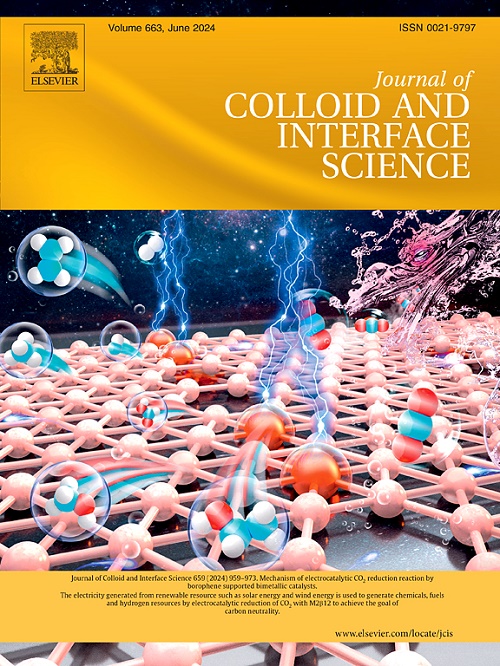基于LDH电催化剂的二维fe - mof的构建及其对氧和尿素的高效释放。
IF 9.7
1区 化学
Q1 CHEMISTRY, PHYSICAL
引用次数: 0
摘要
二维金属有机框架(2D MOF)材料在尿素辅助水电解制氢技术中具有重要的发展前景。但其导电性差、质量渗透率低、稳定性差等缺点限制了其在电催化领域的发展。本文以层状双氢氧化物(LDH)为模板合成了咖啡- bdc。系统研究了不同配体对fe - mof的微观结构和电催化性能的影响。对苯二甲酸由于其空间结构高度对称,酸度较其他配体弱,破坏能力最弱,配位能力最强,导致大量活性位点的产生。fe - bdc具有最佳的电催化活性(析氧反应(OER): η100 = 258 mV,尿素氧化反应(UOR): η100 = 1.34 V,总水分解反应(OWS): E100 = 1.76 V),通过原位傅里叶变换红外光谱和拉曼光谱观察到fe - bdc在1.4 V重构电压下催化转化为FeOOH。本研究为利用模板法制备二维mof材料进行水电解提供了一条新的途径。本文章由计算机程序翻译,如有差异,请以英文原文为准。

Construction of 2D CoFe-MOF derived from LDH electrocatalyst for efficient oxygen and urea evolution
Two-dimensional metal–organic framework (2D MOF) materials have significant development prospects in the technology of urea-assisted water electrolysis for hydrogen production. However, the poor conductivity, low mass permeability, and stability have limited their development in electrocatalysis. Here, CoFe-BDC is synthesized using layered double hydroxides (LDH) as the template. The effect of different ligands of CoFe-MOF on the microstructure and electrocatalytic performance is systematically investigated. Terephthalic acid has the weakest destructive ability and strongest coordination ability due to its high symmetry in spatial structure and its weakest acidity than other ligands, leading to the production of massive active sites. CoFe-BDC has the best electrocatalytic activity (oxygen evolution reaction (OER): η100 = 258 mV, urea oxidation reaction (UOR): η100 = 1.34 V, overall water splitting (OWS): E100 = 1.76 V). CoFe-BDC is observed to undergo a catalytic transformation to FeOOH at a reconstruction voltage of 1.4 V via in situ Fourier transform infrared spectroscopy and Raman spectroscopy. This study provides a new approach of 2D MOFs materials using template method for water electrolysis.
求助全文
通过发布文献求助,成功后即可免费获取论文全文。
去求助
来源期刊
CiteScore
16.10
自引率
7.10%
发文量
2568
审稿时长
2 months
期刊介绍:
The Journal of Colloid and Interface Science publishes original research findings on the fundamental principles of colloid and interface science, as well as innovative applications in various fields. The criteria for publication include impact, quality, novelty, and originality.
Emphasis:
The journal emphasizes fundamental scientific innovation within the following categories:
A.Colloidal Materials and Nanomaterials
B.Soft Colloidal and Self-Assembly Systems
C.Adsorption, Catalysis, and Electrochemistry
D.Interfacial Processes, Capillarity, and Wetting
E.Biomaterials and Nanomedicine
F.Energy Conversion and Storage, and Environmental Technologies

 求助内容:
求助内容: 应助结果提醒方式:
应助结果提醒方式:


